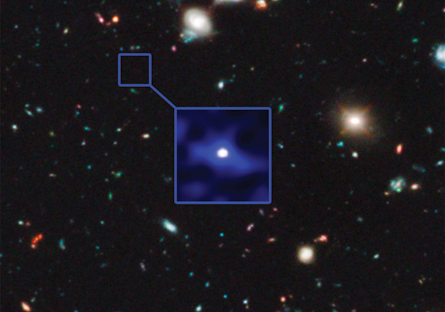Pushing the Hubble Space Telescope to its limits as a cosmic time machine, astronomers have identified what may be the most distant known object in the universe — a tiny galaxy estimated to lie 13.2 billion light-years from Earth and hail from a time only 480 million years after the Big Bang.

Astronomers put the odds at 20 percent that the faint galaxy either lies much closer to Earth than the observations suggest or is merely a spurious light signal, they report in the Jan. 27 Nature. But if the light truly is a glimmer from near the dawn of creation, it could provide new insight about galaxy assembly in the early universe, notes study coauthor Garth Illingworth of the University of California, Santa Cruz.
That insight would stem from how rare such distant galaxies are compared with the 47 galaxies previously found by the team from an era just 170 million years later — some 650 million years after the birth of the universe. Star formation rates must have increased about 10 times during that 170 million years to produce so many additional galaxies in such a short time, says collaborator Rychard Bouwens of Leiden University in the Netherlands.
“The really strong result is the dramatic rise in star formation,” says Illingworth. Even if the team finds other galaxies that could be just as distant as the newfound candidate, “they are very faint and very rare, and that alone tells us that there is a large change [in galaxy formation] between 480 and 650 million years” after the birth of the universe, he says.
Although exciting, “it’s a bit of stretch to draw so much physical intuition about the early universe from what is, after all, a single detection recorded in a single wavelength band,” says galaxy hunter Richard Ellis of Caltech, who was not involved in the new study. The search for extremely distant galaxies has a “checkered history with many claimed detections” that have turned out to be wrong, he adds.
The current confirmed record holder for most distant object is a cosmic explosion known as a gamma-ray burst that erupted in a galaxy 13.035 billion light-years away (SN Online: 4/28/09).
Illingworth and his collaborators used Hubble’s sensitive Wide Field Camera 3, which has taken the deepest infrared portrait of the sky, to detect the candidate remote galaxy.
In late 2009, with half as much Hubble data, the team reported finding three other galaxies that might reside some 13.2 billion light-years from Earth (SN: 1/30/10, p. 5). But after analyzing additional Hubble images of the same patch of sky recorded in 2010, the researchers now say those three galaxies aren’t so distant after all. Instead, the newly reported galaxy, first seen in the 2009 data but not an obvious standout, has now emerged as the best candidate for the most remote galaxy known.
Using the same Hubble images, a rival team led by Rogier Windhorst of Arizona State University in Tempe has also spotted the newly reported galaxy. Windhorst says there’s no doubt the body is a bona fide galaxy and that it’s probably as distant as Illingworth and his collaborators suggest.
But he notes that the researchers may have overlooked a larger population of remote galaxies, because the team excluded regions of the sky that are occupied by nearer, brighter galaxies. In the Jan. 13 Nature, Windhorst and his colleagues reported simulations indicating that nearer galaxies can act as signposts for distant galaxies. That connection stems from a cosmic mirage in which the mass of the nearby galaxies gravitationally bends and magnifies the light from bodies farther away.
Astronomers will need the light-gathering power of the James Webb Space Telescope, the successor to Hubble that won’t be launched before 2015, to precisely measure the distance to any of the galaxies estimated to lie so far away, Windhorst says.







